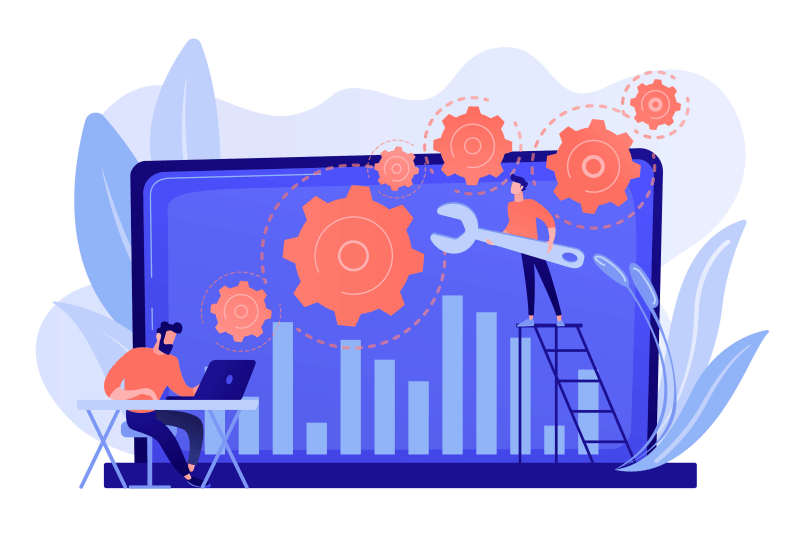Application development has become an integral part of modern business operations. With the rapid growth of technology and the widespread use of mobile devices, the demand for software applications has increased manifold. Besides, from mobile apps to web applications, businesses require custom solutions that can cater to their specific needs and provide a seamless user experience.
In this article, we will discuss the various types of application development, the stages involved in the development process, and the latest trends in the industry.
What Is Application Development?
Application development is the process of designing, building, and deploying software applications for various platforms such as web, mobile, desktop, and cloud. It involves several stages: requirements gathering, design, development, performance testing, deployment, and maintenance.
Furthermore, application development aims to provide software solutions to meet the needs and requirements of businesses and users. It also requires a team of developers, designers, testers, project managers, and other professionals to work collaboratively to ensure the application meets the required quality standards.
Application development is a complex process requiring technical skills, creativity, and project management expertise. However, a well-designed and developed application can provide significant benefits to the users and the business, including increased productivity, improved efficiency, and enhanced customer experience.
Let's check the type of application development.
Types of Application Development
There are primarily two types of application development – mobile and web. Mobile applications are designed specifically for mobile devices, whereas web applications are accessible through a web browser.
Mobile Application Development
Mobile app development involves the creation of software applications specifically for mobile devices such as smartphones and tablets. These apps can be built for various platforms, such as Android, iOS, and Windows. Mobile apps can be native, hybrid, or web-based. The future of Mobile Applications is bright for sure, as mobile users are increasing daily.
Developers build native apps for a particular platform using the language specific to that platform. For instance, Java or Kotlin is used to develop Android apps, whereas Swift or Objective-C is used to create iOS apps. Native apps provide better performance, speed, and security than other types of apps.
Hybrid apps, on the other hand, are a combination of native and web apps. They are built using web technologies such as HTML, CSS, and JavaScript and are wrapped in a native app container. Hybrid apps provide a better user experience than web apps but may not be as fast as native apps.
Web apps are accessed through a web browser and do not require installation on the device. They are written in web technologies such as HTML, CSS, and JavaScript. Web apps are accessible from any device with an internet connection and are platform-independent. However, they may not provide the same level of functionality as native or hybrid apps.
Web Application Development
Web application development involves the creation of software applications that is accessible through a web browser. Developers build applications that can run on various devices, such as desktops, laptops, and mobile devices. Besides, they use various technologies, such as HTML, CSS, JavaScript, and server-side scripting languages like PHP, Ruby on Rails, and Node.js to build web applications.
In some cases, developers also use ready-to-use admin templates as well. An admin template is a collection of web pages created with HTML, CSS, and JavaScript or any JavaScript libraries that are used to form the user interface of a web application's backend. It can save lots of time and money that one needs to invest during web app development. In addition, you can build progressive web apps and SPA using it.
For example, you can check the Sneat MUI React Next JS Admin Template for instance. If you are working on a ReactJS based web application, you can consider such React dashboard template for a hassle free development process.
There are basically two types of web applications – static and dynamic. Static web applications are basic websites that provide information to the user. They do not require any interaction with the server and are primarily used for informational purposes.
On the other hand, dynamic web applications provide a more interactive experience to the user. They require interaction with the server and can provide various functionalities such as user authentication, data storage, and retrieval. Dynamic web applications can be built using various JavaScript frameworks such as AngularJS, ReactJS, and Vue.js.
Methodologies of Application Development
Successful projects are well-managed. To effectively manage a project, the manager or development team must select the software development methodology that is best suited to the project at hand. Every methodology has different strengths and weaknesses and exists for various reasons.
Here's an overview of the most commonly used software development methodologies and why they exist.
Agile Development Methodology
The Agile development methodology is an iterative and flexible approach to software development that emphasizes collaboration, customer satisfaction, and rapid delivery. The methodology involves breaking the project down into smaller, manageable pieces called sprints, which typically last between one and four weeks. At the end of each sprint, the team reviews and adjusts its progress and priorities based on feedback and changing requirements.
There are several benefits of Agile methodology. First, it emphasizes communication and collaboration between developers, customers, and stakeholders, promoting flexibility and adaptability in response to changing business needs. The result is a more customer-focused approach that delivers high-quality software in a shorter timeframe.
DevOps Deployment Methodology
DevOps deployment methodology is a software development approach that focuses on collaboration and automation between development and operations teams to improve software delivery speed, quality, and reliability.
The methodology involves using Continuous Integration, and Continuous Deployment tools to automate the build, test, and deployment process, ensuring code changes are thoroughly validated before they are deployed to production. DevOps deployment methodology enables teams to reduce the time and effort required to release new features or updates, allowing them to respond quickly to changing customer needs and market demands.
Waterfall Development Method
The Waterfall model is a traditional linear software development methodology that flows sequentially through conception, initiation, planning, design, construction, testing, deployment, and maintenance phases. The software development team defines requirements upfront and completes each phase before moving on to the next.
The Waterfall methodology can become inflexible when there are changes to requirements or a need for iterative development. Additionally, the methodology may not catch errors until later in the project cycle, making it more difficult and costly to address them.
Rapid Application Development

Credit: infragistics
Rapid Application Development (RAD) is a software development methodology that emphasizes speed and flexibility in the development process. The methodology involves breaking down the project into small modules and using iterative development to quickly build, test, and refine the software.
RAD typically involves the use of visual tools, prototyping tools, and user feedback to speed up the development process. RAD aims to deliver a working prototype of the software to customers early in the development cycle, allowing for early feedback and adjustments. This approach enables developers to quickly respond to changing customer needs and deliver a high-quality product in a short amount of time.
Now, let's head toward the stages of Application Development.
Stages of Application Development
Application development involves several stages, each of which is essential for the success of the project. The following are the various stages of application development:
Planning
The planning stage is crucial to the success of the project as it sets the foundation for the rest of the development process. During this stage, the development team works with the client to define the project objectives, target audience, and the features and functionalities that the application should have. The team also determines the project scope, budget, and timelines.
The outcome of this stage is a comprehensive project plan that outlines the requirements, scope, timelines, and budget. The plan serves as a roadmap for the development team and ensures that everyone is on the same page before proceeding to the design stage.
Design
The design stage involves creating wireframes and prototypes of the application. This stage consists of the user interface (UI) and user experience (UX) of the application. Next, the design team works with the development team to ensure that the design is technically feasible and aligns with the project requirements. The design team here uses different tools, such as UI Kits, prototyping tools (like adobe and Figma), wireframes, etc. design an appealing app.
The outcome of this stage is a visual representation of the application, including the layout, color scheme, typography, and other design elements. Usually, the client reviews the design for approval before proceeding to the development stage. A well-designed application is critical to its success as it directly impacts user engagement and retention.
Development
The development stage is where the actual coding takes place. Here, the development team follows the design guidelines and uses the required technologies and tools to build the application. The development team usually works in sprints, with each sprint delivering a set of features or functionalities.
During the development stage, the team adheres to the best practices for coding, documentation, and version control. The team also ensures the optimization of the code for better performance, security, and scalability. Regular communication and collaboration between the development team, the design team, and the client are essential to ensure that the development aligns with the project requirements.
The outcome of this stage is a working application that meets the project requirements. To make sure that application is bug-free, the developer team rigorously tests it with various testing methods. If they find any issues or bugs, then they fix them before proceeding to the deployment stage. A well-developed application is critical to its success as it directly impacts user experience and satisfaction.
Testing
The testing stage involves validating the functionality, performance, and usability of the application. The testing team uses various testing methods, including unit testing, integration testing, system testing, usability testing, and user acceptance testing (UAT), to ensure that the application works as expected.
During the testing stage, the team identifies and documents any issues or bugs and communicates them to the development team for fixing. The team also ensures that the application is accessible, responsive, and user-friendly. The software testing stage is critical to the success of the project as it ensures that the application is ready for deployment.
The outcome of this stage is a tested and validated application that meets the project requirements. Next, the testing team provides a report of the testing results, including any issues or bugs, to the development team for fixing. Finally, after resolving all the issues, the application becomes ready for deployment.
Deployment
The deployment stage involves releasing the application to the production environment. The deployment team follows a deployment plan that outlines the steps required to deploy the application. The team ensures deployment of the application goes without any downtime or disruption to the users. The deployment stage is critical to the success of the project as it ensures that the application is available to the users.
The deployment team also ensures that the application is secure and meets the required standards and regulations. In addition, the team monitors the application after deployment to ensure it performs optimally. Any issues or challenges that arise during the deployment process are documented and communicated to the development team for future reference.
After the deployment of the application, the development team provides ongoing maintenance and support to ensure that the application continues to function optimally. A successful deployment ensures that the application is accessible to the users and meets their expectations.
Maintenance
The maintenance stage involves the ongoing support and maintenance of the application. The development team provides ongoing maintenance and support to ensure that the application continues to function optimally. In addition, the team monitors the application for any issues or bugs and fixes them promptly.
During the maintenance stage, the development team also ensures that the application is updated with the latest technologies and security patches. In addition, the team also adds new features and functionalities as required by the client. The maintenance stage is critical to the success of the project as it ensures that the application continues to meet the user's requirements and expectations.
The outcome of this stage is a well-maintained application that continues to function optimally and meet the user's expectations. In addition, a successful maintenance stage ensures that the application remains relevant and continues to provide value to the users.
Now, let's check the app development trends you should know.
App Development Trends in 2024
In 2024, many changes will be expected in the app development world. Well, the following are some burning application development trends that will indeed rule the world.
Adoption of Cloud Technology
The Future of Cloud Engineering is evolving as cloud technology is a game changer in application development. It enables businesses to easily scale their IT infrastructure, reduce costs, and increase agility. The adoption of cloud technology is increasing daily as it provides access to resources and services on-demand, allowing businesses to focus on their core competencies.
Application developers can use cloud technology to build and deploy applications in a distributed environment, which allows users to easily access them from any location using any device with an internet connection. As more businesses recognize the advantages of cloud technology and transfer their IT operations to the cloud, this trend will definitely continue.
Usage of AI and Machine Learning Technologies
AI and machine learning technologies are transforming the way we interact with applications. From personalized recommendations to intelligent chatbots, AI and machine learning are revolutionizing the user experience. ChatGPT is the latest example of it. These technologies enable applications to learn from user behavior and preferences, providing a more personalized experience.
Developers use these technologies to improve application performance, optimize resource utilization, and reduce maintenance costs. As more data becomes available, AI and machine learning algorithms become more accurate and effective. This application development trend will continuously evolve as AI and machine learning technologies become more accessible to developers and businesses alike.
Metaverse-Like Experiences
Metaverse-like experiences are a new trend in application development. These experiences are immersive and interactive, providing users with a virtual environment to explore and interact with. This trend will remain for upcoming years with the increasing popularity of virtual and augmented reality technologies.
The metaverse will become a major part of the digital landscape, providing users with a new way to engage with applications and each other. Developers are exploring new ways to incorporate metaverse-like experiences into their applications, creating new opportunities for businesses to engage with their customers.
Integration of Mobile Apps With Other Devices and Platforms
Integration of mobile apps with other devices and platforms is another trend in application development. The proliferation of mobile devices has led to increasing demand for applications that can be accessed from multiple devices and platforms. As a result, developers are using technologies such as APIs and SDKs to enable seamless integration between mobile apps and other devices and platforms.
The core reason behind this application integration trend is the need to offer users a consistent experience, regardless of their device or platform. Developers and businesses can expect this trend to persist as more devices become connected and provide new opportunities.
Improved Native Cybersecurity

Improved native cybersecurity is a critical trend in application development as privacy and security have become major concerns for businesses and users alike. Furthermore, with the increasing number of cyber threats, applications need to be secure and resilient.
Developers are incorporating security features into their applications from the ground up, making security an integral part of the development process. This includes features such as encryption, authentication, and authorization. In addition, as cyber threats continue to evolve, developers are expected to continue to improve native cybersecurity, ensuring that applications remain secure and resilient.
Low Code/No Code Is the Future
As per a report, the low-code development market will generate $187 billion by 2030. Low-code/no-code platforms are becoming increasingly popular among businesses and app developers. These platforms allow developers to create applications using visual interfaces and drag-and-drop components without requiring extensive programming knowledge. This trend will continue in upcoming years as more businesses and developers embrace the benefits of low-code/no-code platforms, such as faster development times and reduced costs.
Conclusion
Well, here we briefly discussed application development, consisting of various types, stages, and trends. The intention here is to provide you with a comprehensive overview of the Application Development process, what it requires, and what trends will be vital in 2024.
We hope you find this article noteworthy and helpful. If you have any inputs, you can share them with me through the comment section.























Top comments (0)